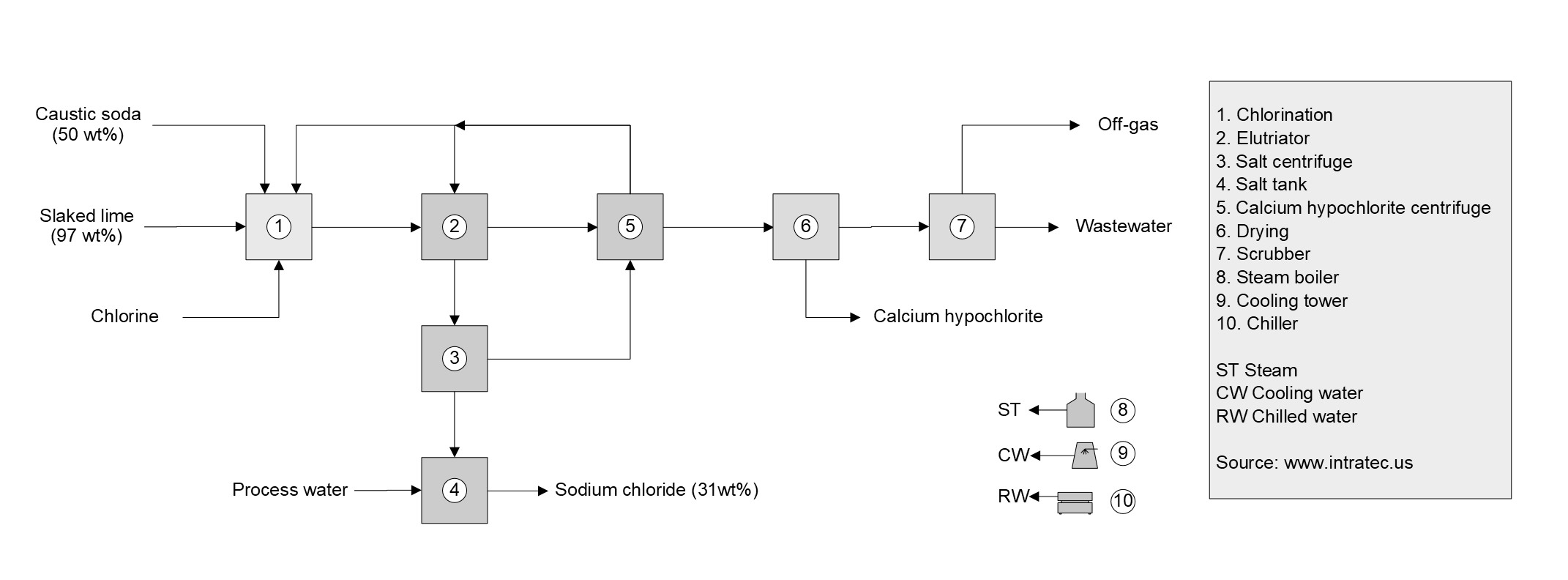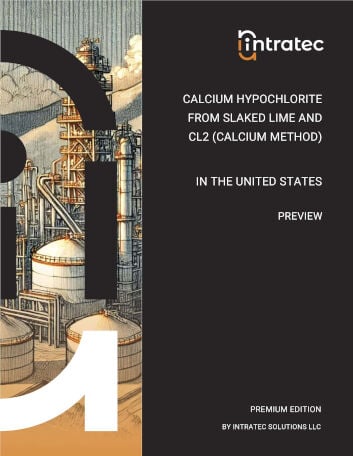Commodity Production Costs Report
Calcium Hypochlorite from Slaked Lime and Cl2 (Sodium Method)
Calcium Hypochlorite Plant Capital & Operating Cost Analysis | United States | Q4 2025
This report presents the economics of Calcium Hypochlorite production from slaked lime, sodium hydroxide, and chlorine. The process examined is a typical sodium process. This process consists mainly of passing chlorine into a slurry of slaked lime and sodium hydroxide, generating Calcium Hypochlorite and sodium chloride. After separation steps, Calcium Hypochlorite (about 70 wt%) and an aqueous solution of sodium chloride are obtained as products.
The report provides a comprehensive study of Calcium Hypochlorite production and related Calcium Hypochlorite production cost, covering three key aspects: a complete description of the Calcium Hypochlorite production process examined; an in-depth analysis of the related Calcium Hypochlorite plant capital cost (Capex); and an evaluation of the respective Calcium Hypochlorite plant operating costs (Opex).
The Calcium Hypochlorite production process description includes a block flow diagram (BFD), an overview of the industrial site installations, detailing both the process unit and the necessary infrastructure, process consumption figures and comprehensive process flow diagrams (PFD). The Calcium Hypochlorite plant capital cost analysis breaks down the Capex by plant cost (i.e., ISBL, OSBL and Contingency); owner's cost; working capital; and costs incurred during industrial plant commissioning and start-up. The Calcium Hypochlorite plant operating costs analysis covers operating expenses, including variable costs like raw materials and utilities, and fixed costs such as maintenance, labor, and depreciation.

The process under analysis comprises three major sections: (1) Reaction; (2) Separation; and (3) Finishing.
Reaction. Initially, caustic soda solution is mixed with recycled bleach mother liquor, composed of Calcium Hypochlorite and sodium chloride dissolved in water. The resulting solution is combined with slaked lime to form a milk of lime slurry. Such milk is mixed with more liquor recycle and recycled bleach mother liquor. The resulting solution is supersatured with sodium chloride and Calcium Hypochlorite, initiating the precipitation of crystals. Then, the mixture is fed into a chlorinator along with gaseous chlorine, which reacts with calcium hydroxide and sodium hydroxide to form Calcium Hypochlorite and sodium chloride. In this way, new Calcium Hypochlorite and sodium chloride crystals are formed and the preexisting ones increase in size.
Separation. The chlorinator outlet slurry is fed at the midpoint of a two-stage upward flow cylindrical elutriator-classifier. Bleach mother liquor is fed at the bottom portion of the lower stage of the elutriator as the elutriating fluid. The upper stream of the elutriator, an aqueous slurry containing most of Calcium Hypochlorite, is sent to Calcium Hypochlorite centrifuge. The bottom product of the elutriator, an aqueous slurry containing the denser sodium chloride crystals, is centrifuged; the sodium chloride wet cake is then conveyed to an intermediate tank. The salt centrifuge mother liquor is sent to the Calcium Hypochlorite centrifuge.
Finishing. The wet cake from Calcium Hypochlorite centrifuge is dried in a turbo dryer; the gas from the dryer is scrubbed and released. Dry Calcium Hypochlorite is squeezed, prilled, and then classified; the oversize and undersize solids are returned for further processing, while the Calcium Hypochlorite product is directed for packaging.
Report in PDF Format
Download & Explore Anytime
Access in Various Devices
Print & Read Comfortably
Share With Co-workers
Up-to-date Report
Professional report based on Q4 2025 economic data, ensuring timely evaluations.
Multiple Use Cases
Ideal for investment screening, feasibility studies, cost estimates, and research planning.
Proven Methodology
Developed using a consistent methodology honed over a decade, ensuring reliable cost analyses.
Report Editions
Content Highlights
Plant Capital Cost Summary
Summary outlining the capital cost required for building the Calcium Hypochlorite production plant examined.
Plant Capital Cost Details
Detailing of fixed capital (ISBL, OSBL & Owner’s Cost), working capital and additional capital requirements.
Plant Cost Breakdowns
Breakdown of Calcium Hypochlorite process unit (ISBL) costs and infrastructure (OSBL) costs; plant cost breakdown per discipline.
Operating Costs Summary
Summary presenting the operating variable costs and the total operating cost of the Calcium Hypochlorite production plant studied.
Operating Cost Details
Detailing of utilities costs, operating fixed costs and depreciation.
Plant Capacity Assessment
Comparative analysis of capital investment and operating costs for different Calcium Hypochlorite plant capacities.
Production Process Information
Block Flow Diagram, descriptions of process unit (ISBL) and site infrastructure (OSBL).
Process Consumptions
Raw materials and utilities consumption figures, by-products credits, labor requirements
Process Diagrams
Process flow diagrams (PFD), equipment list and industrial site configuration
Other Calcium Hypochlorite Production Cost Reports

Calcium Hypochlorite from Slaked Lime and Cl2 (Calcium Method)
This report presents the economics of Calcium Hypochlorite production from slaked lime and chlorine via a typical calcium process. In this process, slaked lime is hydrated and chlorinated. A mixture of Calcium Hypochlorite, calcium chloride, and calcium hydroxide (also known as bleaching powder) is obtained as the final product. The economic analysis is based on a plant located in the United States.
Details: 25 kta United States-based plant | Q4 2025 | 107 pages | Issue B | From $1,199 USD
Bundle & Save
Purchase multiple Calcium Hypochlorite Production Cost reports and enjoy tiered discounts
up to 10% off!
Could Not Find the Report You Need?
Obtain a Bespoke Report
Get a report targeting the process in which you are interested
See Offer Details
Understand Bespoke Reports and how you can easily order them
Check Editions & Pricing
Complete a brief form and see a quotation for your Bespoke Report
Other Related Production Cost Reports

Chlorine Production from Sodium Chloride (Diaphragm Process)
This study presents the economics of Chlorine production from sodium chloride via a diaphragm plant located in the United States. In the process under analysis, an aqueous solution of sodium chloride (brine) is decomposed electrolytically in a diaphragm cell, producing Chlorine, sodium hydroxide and hydrogen.
Details: 550 kta United States-based plant | Q4 2025 | 107 pages | Issue B | From $799 USD

Sodium Hydroxide Production from Sodium Chloride (Diaphragm Process)
It presents the economics of Sodium Hydroxide production from brine in the United States. The process examined in this report is a typical diaphragm process. Chlorine and hydrogen are also generated as by-products in the process.
Details: 600 kta United States-based plant | Q4 2025 | 107 pages | Issue B | From $799 USD

Chlorine Production from Sodium Chloride (Membrane Process)
This study presents the economics of Chlorine production from sodium chloride via a membrane process plant located in the United States. In the process under analysis, an aqueous solution of sodium chloride (brine) is decomposed electrolytically in a membrane cell, producing Chlorine, sodium hydroxide and hydrogen.
Details: 500 kta United States-based plant | Q4 2025 | 107 pages | Issue A | From $799 USD

Sodium Hydroxide Production from Sodium Chloride (Membrane Process)
This report presents the economics of Sodium Hydroxide production from sodium chloride in the United States, via a typical membrane process. In this process, sodium chloride is decomposed electrolytically, producing sodium hydroxide. Chlorine and hydrogen are generated as by-products in the process.
Details: 550 kta United States-based plant | Q4 2025 | 107 pages | Issue A | From $799 USD
+800 Reports Developed, Targeting +250 Commodities
Vast Report Library
858 independent and up-to-date reports examining embryonic and established production processes.
Free Sample Reports
Quickly understand the structure and depth of content of our professional reports.

